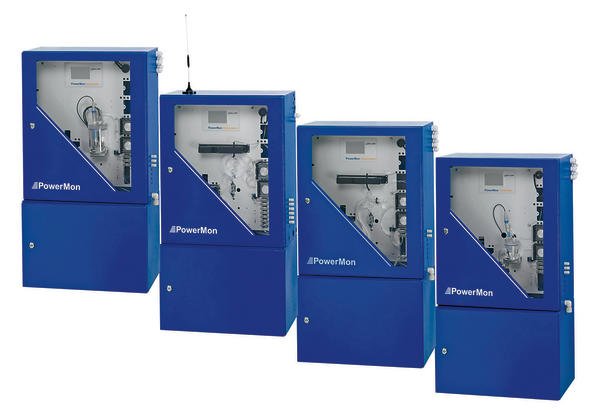PowerMon process analysers measure trace concentrations of different parameters with the help of wet chemical methods. Depending on the equipment, they can be used for colorimetric, titrimetric or potentiometric measuring techniques. Up to 100 external sensors can be connected to determine the required parameters.
The PowerMon series was developed by Bran+Luebbe especially for long-term operation in industrial environments. It is typically used in the energy industry, water treatment, chemical engineering, chemical surface treatment and waste water engineering, where it offers daily proof of its suitability. The series is characterised by a robust design that is geared to practical needs. The devices operate fully automatically with the help of wet chemical methods. In addition to higher precision and shorter measuring cycles, they also provide self-monitoring and auto-recalibration functionality. PowerMon analysers measure trace concentrations of different parameters, such as phosphate, nitrate, ammonium, chlorine, metals and silica in liquids. Various measurement techniques are necessary, depending on the parameter to be measured and the branch of industry in which the analyser is used. Up to 100 external sensors can be connected for this purpose. The PowerMon acts as a measuring transducer for these sensors. Concurrent processing of the individually measured values is also possible.
PowerMon analysers can additionally be adapted to specific measurement requirements and integrate multi-measuring point technology. Their low reagent consumption and long maintenance intervals result in minimal operating costs. Variable-speed peristaltic pumps reduce the time per measuring cycle and accelerate the availability of the measured values. The extremely precise dual-beam photometer with an accuracy equivalent to ±3 % of the measured value represents a further advantage. By using extended interfaces, the analyser can be connected to a computer network or a telephone system to enable remote diagnoses of the process to be carried out centrally by the customer, saving considerable time and effort.
Suitable for waste water treatment
PowerMon analysers can be used very successfully, amongst other things, for process control in waste water treatment systems. Here, the measured value serves as the manipulated variable for a closed-loop system. The analysis result can be corrected by changing the input component, for example by altering the concentration of phosphate in the waste water in order to control the precipitant dosage or the reaction conditions. The compulsory documentation of individual measuring results acts as evidence that the facility is functioning correctly and forms the basis for evaluations of pollutant emissions.
A multitude of process reagents are employed for surface treatment in steel manufacturing companies. Effluents from these processes are for the most part highly contaminated with heavy metals, acids, complexing agents and inhibitors. To neutralise the heavy metals, the pH is adjusted by adding acid or base following suitable pre-treatment, so that they are precipitated as hydroxides. The process water is conditioned in a series of processes and then either reused or discharged as waste. The waste water is continuously monitored for free cyanide at the outlet of the waste water treatment plant. If the limit value is exceeded, the water is no longer allowed to be discharged into the river. The cyanide concentration can be measured colorimetrically. In the first step, the sample is neutral-ised by the PowerMon colorimeter. At the same time, cyanide reacts with chlorine to form chlorine cyanide. An azo dye, which can be measured colorimetrically, is produced by the nitrohydrochloric reaction after adding pyridine barbituric acid.
The system workstation is also capable of integrating other measuring devices (for determining the ammonium concentration, pH, turbidity, conductivity, oxygen, etc.), so that a complete measurement station can be combined in a single unit. Even minute changes can be detected immediately with the help of direct spectrometry or photometry. This option is particularly useful in early warning systems for drinking water supplies to detect abnormal events that could affect the raw water quality (such as the appearance of cyanide).
cpp 428
PowerMon
Process Expo 2008
Share:







